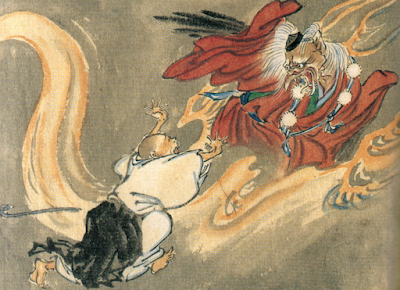 |
| Yamata no Orochi from the Nihon-ryakushi - Susanoo by Tsukioka Yoshitoshi |
Yokai are a wide category of monsters, ghosts and other supernatural beings of Japanese myth. They are as diverse as Japan's historical imagination and could be fearsome or tame, powerful or weak, villainous or good.
Most well known yokai are stock characters who show up in
countless old myths. In many cases, they are described in contradictory terms
from one myth to another without much consistency. Some yokai are based on very
old stories that have been recounted in every village in a slightly different
way for hundreds of years. Others were invented in the Edo-era by ukiyo-e
artists and writers of fiction, noh theatre or kabuki plays.
The following are a few prominent examples of yokai.
1. Obake
Obake is a general term for any creature that can shapeshift
into human form. Japanese mythology typically shows much respect for the
intelligence of animals and they are often portrayed as having supernatural
powers including the ability to shapeshift. The purpose in shapeshifting is
inevitably to play some trick on humans. Animals that were historically thought
to shapeshift include foxes, raccoon dogs, badgers and cats. Kami, demons and
plants were also thought to shapeshift. In many Obake stories, a demon
shapeshifts to a beautiful woman.
2. Yurei
Yurei is a wide category of Yokai that are essentially
ghosts although in most cases they are technically kami. They are spirits who
are kept from a peaceful afterlife due to revenge, love, jealousy, hatred or
sorrow. Historically, Yurei were taken very seriously as it was believed that
they could cause disasters, famine and tragedy. In some cases, vast amounts of
money were spent to build temples and shrines to appease angry ghosts. Where
yokai stories are often half comical, yurei stories tend to be more intense.
They are usually sad, terrifying or both.
3. Rokurokubi
Rokurokubi are much like regular humans during the day but
at night their necks become very long or their heads pop off their bodies and
float around.
4. Tengu
Tengu are Japanese bird monsters that often take on human
form. As humans, they have huge noses. In the old days, they were feared as
terrible creatures that corrupted people. In modern times, Tengu are
increasingly viewed as complex characters with a good side. They are fierce
protectors of sacred Japanese forests and mountains. As such, they are
sometimes venerated at Japanese temples or shrines and may perform rituals at
matsuri.
5. Kappa
Kappa are river monsters that may have originally been based
on Japanese giant salamanders. They are depicted in myth as drowning people and
causing terrible problems. However, they also have some good qualities. They
can speak Japanese and are thought to always keep their word. Kappa also enjoy
a good sumo wrestling match. The myth of Kappa served a practical purpose as
preventing children from drowning in rivers. Parents would tell their kids that
if they swim in the river alone, a kappa will get them. On family picnics by
the river, people would throw cucumbers into the river as this was said to
satisfy the kappa. Many dangerous sections of Japanese rivers are still marked
with kappa warning signs today.
6. Kintaro
Kintaro, literally "golden boy", is amongst
Japan's most famous traditional heroes. He is a child of superhuman strength
who is raised in the wilds and is able to communicate with animals who are his
partners on his adventures. There are countless variations of the Kintaro myth
with some saying he was raised by a Yamauba and others claiming he was raised
by a princess.
7. Yamauba
Yamauba are a category of character in Japanese myth
described as monstrous old women with an unkept appearance who live deep in the
mountains. They are occasionally ascribed hideous features such as a mouth on
top of their head. They typically pretend to be kindly old women in order to
trick people and do terrible things. Yamauba are portrayed as having a
ghost-like existence.
8. Tsukumogami
Tsukumogami are formerly inanimate objects who become
animate and self-aware on their 100th birthday. It is traditionally said that
any regular household items such as umbrellas, sandals, futon beds, kitchen
utensils become tsukumogami if they survive to 100 years of age. Tsukumogami
are thought to have a ghost-like existence and can shapeshift into human form














No comments:
Post a Comment